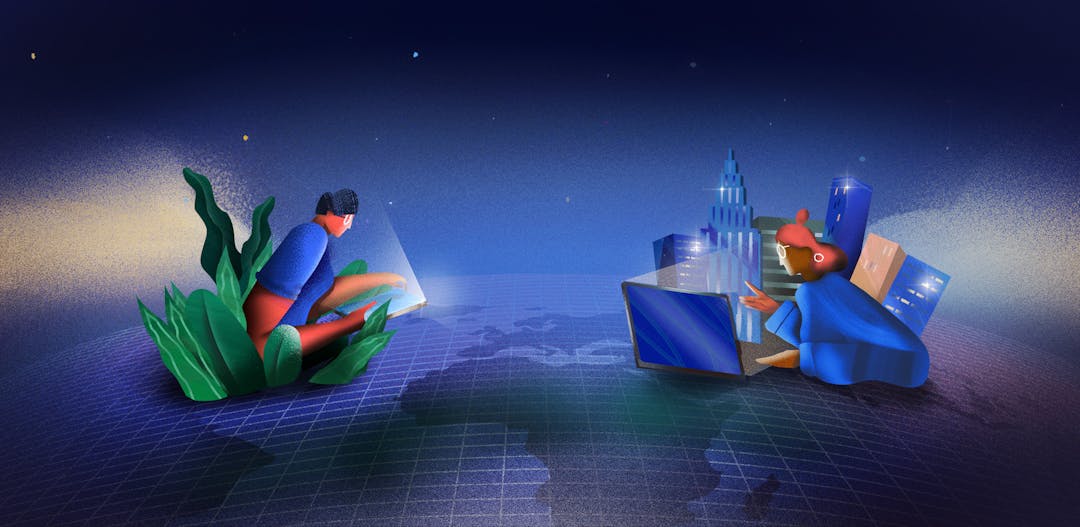The pandemic forced us to change the way we work, but with lockdowns out of the picture, how are businesses moving forward?
For one, we’ve seen a move from 9 to 5 office life to more flexible ways of working - sorry, Dolly Parton. While some companies go fully remote, some hybrid, and others keep it traditional, we take a look at the digital-first phenomenon, in particular.
This is where businesses set themselves and their employees up for an entirely digital way of working, but that doesn’t mean they have to scrap the ‘traditional’ idea of offices and co-working spaces. Digital-first companies give people the flexibility to work in the way they want, helping to improve the work-life balance of employees around the world and also opening the doors to a much broader range of talent.
Here are eight steps to introducing digital-first ways of working into your business:
1) Enable creative spaces everywhere
Good work settings and well-equipped workspaces are known to help with creativity and productivity. But how can you guarantee this when your employees aren’t office-based all the time, or at all?
With regular working from home, people need to make the most of what they’ve got in terms of space and equipment. This isn’t ideal for everyone.
Offering your employees a workspace stipend to go towards creating a comfortable and practical environment that suits their needs will encourage motivation and productivity. And you know what that means? Great work and great morale.
If possible, giving your employees access to an office space or hub proves beneficial too - for those that prefer working away from home, or those that want to come into a more collaborative in-person space for meetings, workshops, or the social aspect.
2) Make the most of all the digital collaboration tools out there
Use digital collaboration tools so your employees can work together seamlessly, wherever they are. There are game-changing tools out there for knowledge sharing, planning, ideation, and communication processes. They’re suitable for all kinds of companies, and help improve operations for teams working in all the ways: remote, hybrid, or office-based.
Some examples? Absolutely, here are some popular contenders:
- Knowledge sharing : Nuclino, Notion, Confluence, Google Drive
- Planning and project management : Trello, Monday, Asana
- Ideation : Miro, Mash-up
- Communication : Slack, Zoom, Teams, WhatsApp
It’s important to bring everyone together in a virtual space, which can be tough with the absence of universal working days, times and styles. With digital collaboration tools like these, you help to achieve transparency across your business, as well as employee participation, engagement and inclusivity.
3) Establish a common virtual etiquette
Whichever video conferencing service your organization uses, you need to implement some kind of etiquette across the board. This will not only help with general communication and engagement, but to keep all employees included and feeling seen no matter where they are based.
Some examples:
- One person, one screen: If some or one person is remote, everyone in the office hub should use their separate laptop
- Camera on : If you’re comfortable doing so, we suggest the camera being on to make the conversation as natural as possible (and get to know each other properly as a team!)
- Gallery view on: Stick on Gallery mode so you can see everyone and create more sense of community, no matter what the distance is between you all
- Google Speedy Meetings : Using this setting, we build in refreshment breaks (5 min or 10 mins) and ensure employees aren’t on back-to-back Zoom calls
- Meeting-free days: The times of working from home have left behind a case of Zoom fatigue for many, put forward a meeting-free day across your company to ease that
4) Schedule regular all-company meetings
Talking of company-wide meeting etiquette leads us nicely onto our next point: company-wide meetings. As a digital-first company, these should be hosted via your video conferencing tool, and should be hosted regularly.
For those that work remotely or don’t come into the office a lot, it can be difficult to understand where the company is at as a whole. Weekly or monthly meetings (whichever you feel necessary) can make sure everyone is up to speed and working towards the shared business and growth strategy. 📈
To power the sense of community and employee engagement in these kinds of meetings, you can use tools like Slido, where questions (named or anonymous) can be submitted, or Mentimeter to make the presentation itself more interesting and interactive.
5) Make time (and $$$) for socials and celebrate successes
Another way to boost employee engagement, and general morale? Make time for both company-wide and team social events.
Whether that’s getting everyone together in one place, covering their travel and accommodation costs, or hosting virtual socials. The range of virtual entertainment has really peaked as a result of the pandemic - we’ve seen everything from quizzes and bingo to cocktail making and cooking masterclasses. Make the most of it.
And if you don’t have the time or the budget for regular socials and celebrations, shout-outs across your email or communication channels are so good for motivation all round. Never let any hard work go unnoticed - it’s something that can quickly lead to disengagement, particularly when team spirit can’t come into play throughout the full working day in the same way it can when everyone’s physically together.
6) Trust in your employees to do their best work
Trust is essential when it comes to all working environments, but with digital-first granting employees the freedom to work how, when, and where they’d like, it needs that little bit extra.
People’s best work is produced when their working environment is entirely suited to them. That might be at home in front of a desk with three monitors and some cacti, that might be a commute into the office a few days a week with an excuse to read that book you got for Christmas, or that might be fully office-based with the guarantee of a fully stocked coffee machine. All people are unique, and so are their working habits.
Trust your employees to know what works for them, so they can do their best work for your business.
7) Support the health and wellbeing of your employees
With virtual ways of working, it can be more difficult to determine the health and wellbeing of individuals. Whether that’s picking up signs and signals that people might be struggling, or those that are struggling not feeling able to speak out, it’s important to create a safe and supportive space - even if you are fully digital.
As a company, you can organize wellbeing classes, like yoga or meditation, or groups for employees to get involved with on a regular basis. Easy to do over Zoom or online, these activities get people moving, thinking, and team-building, and shows your business’s support and care for its employees.
Encourage mental health first aid training as much as you do physical first aid training in the office too. And if there’s room in the budget, there are a lot of counseling and therapy businesses out there that take on corporate clients, giving your employees access to regular and confidential support if they need it. We’re fans of Sanctus .
8) Remember it’s a continuous company effort
Don’t forget that, like anything digital, things change - and they can change fast. It’s important to keep up all the efforts mentioned above as both an employer and a company as a whole.
Encourage regular feedback from your employees and iterate your approach as you go. Over time, you’ll find out what works for your business and what doesn’t. As your business grows, so will your business’ ways of working.
If you're a fan of a digital-first way of working, we've got roles available at Paddle. Check them out.




